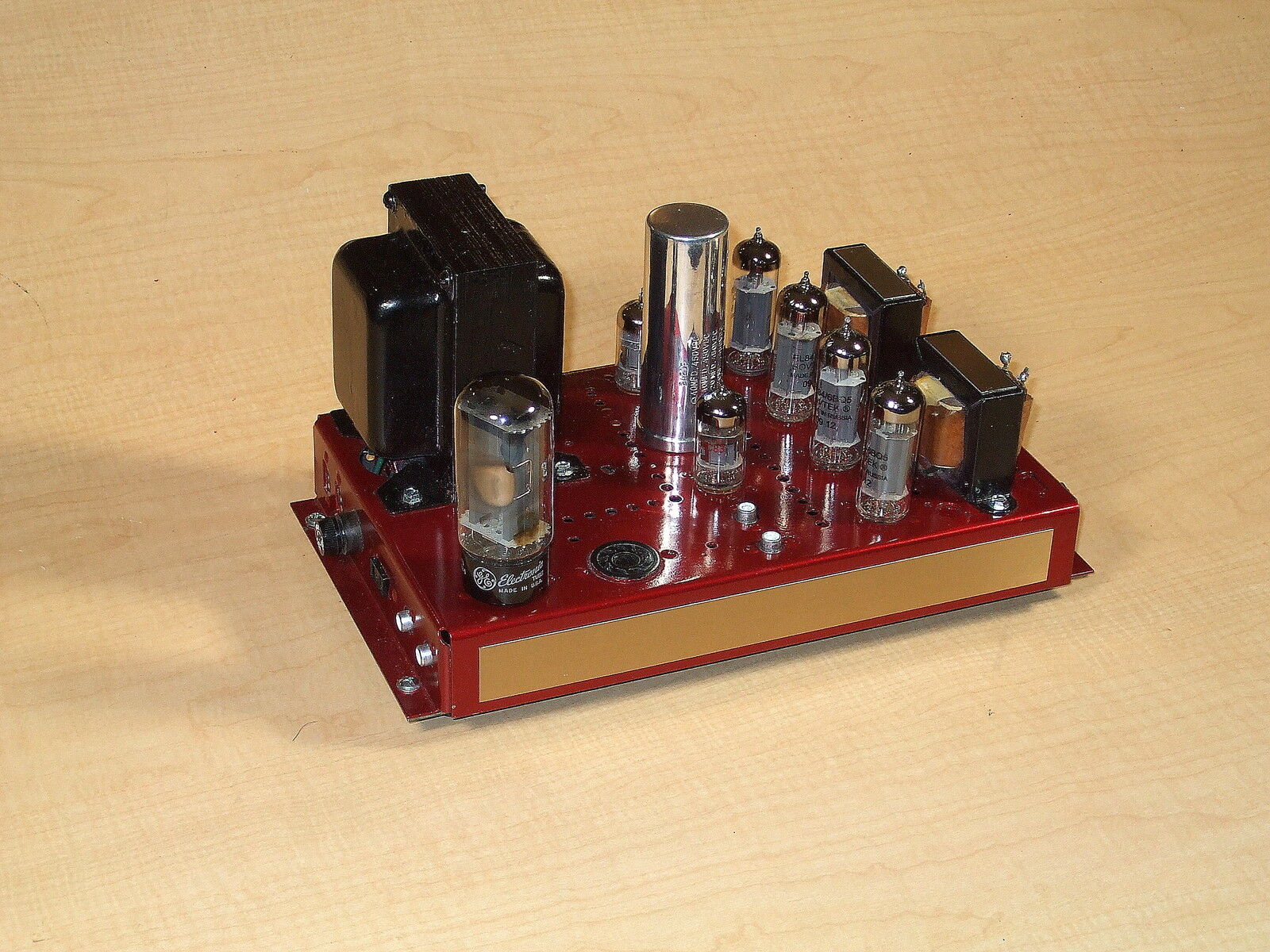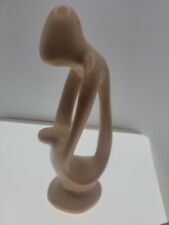When you click on links to various merchants on this site and make a purchase, this can result in this site earning a commission. Affiliate programs and affiliations include, but are not limited to, the eBay Partner Network.
HERE WE GO AGAIN! I NOW HAVESIXMORE OF THESE BABY SILVER SEVENS. I LOVE THIS LITTLE AMPLIFIER, AND EVERYTIME I LISTEN TO IT IHAVE TO ASK MYSELF\"HOW DOES IT DO THAT?\"
BabySilver Seven Amplifier
20 Watts per channel continuous
Not so baby:With speech and music, 40 W rms per channel, 80 W rmstotal!
Restored and Designed by Bob Carver
When this small amplifier appeared on my doorstep one day, I found myself holding a very worn and tired vintage console amplifier, typical of units found in 50 year old console stereo systems. These consoles were built by the millions in the 1950s and 1960s, and I ordered this amplifier on a whim one fine day as I was window shopping on . I hooked it up, and to my great surprise it worked! It sounded quite nice, not much power (about 12 watts, weak output tubes), and its overall performance was similar to many other 6BQ5 amplifiers. Except for the low power of course. Upon closer inspection, I noticed that its output transformer was rather amazing in that its bandwidth was so good it was difficult to believe. It was so good it truly was NOT to be believed. I tried to find out who designed it for Packard Bell so long ago, for It seemed to me to have the signature of Stu Hegeman written all over it. Stewart Hegeman was a Top Gun for hire in those days, and designed many output transformers and amplifiers for a vast armada of companies. Most notably Harman Kardon, Lafayette, and several other big-name companies.
My heroes are Einstein, Gandhi, Hegeman. Anyway, this small output transformer seemed too good to be true. It wasn\'t, of course, it was simply designed by a genius. I spent many days trying to find out who designed it; I checked with Packard Bell, and looked at all the archival information I could get my hands on. I think I found every schematic ever drawn for this small, unassuming tube amp. I found four of them, one from Sam\'s Photofact, one from Packard Bell, one from Vintage Schematics, and one that was embodied in the amplifier itself that I traced. Not anywhere on any of the schematics was I able to find a single name! After talking with Packard Bell for hours, I finally got the name of a man who used to work in the audio division of Packard Bell, one David Jenkins, who was a very young apprentice way back then. He remembered that an old man (to this youngster anyway) whose name he could not remember, but remembered that he was an outside consultant for the company, and designed many amplifiers for many companies. Citation sounded familiar to David, but that was all. That was enough for me! Taking all the evidence together, I am now virtually certain this output transformer, if not the whole amplifier, WAS designed by Stu.
I put it on my laboratory bench and set about designing a new amplifier. I retained the best of what I decided Stu had created: I have increased the energy storage by ten-fold, a full order of magnitude. Vintage designers, even genius ones, could only dream about such energy storage capacity. I increased the open loop gain, I changed the response to reflect my latest thinking regarding amplifier response design. I incorporated my new circuit I called a DC restorer. Actually, I copied it from a T.V. schematic from the old vacuum tube days. I have regulated the screen voltage, andthe bias voltage for the output tubes is an auto bias circuitthat includes the DC restorer. I have includeda regulator that insures the bias voltageremains locked to its design center, and have installed extremely low-leakage coupling capacitors. The output tubes arecarefully tested dual pairs of vintage units, andthe driver and input tubes are also vintage units that sound stunning. In addition, the rectifier is a powerful, fullsize 5U4. Beyond that I\'ve given it every deluxe circuit feature known to Man, Woman, or minor Wizard. Not only that, but I will send along an extra set of output tubes just to make certain thatyour amp will operate for another 50 years, even if an output tube should fail in the distant future. It\'s part of my lifetime warranty. One more thing; I accept any form of rational payment.
Thepower output is about 20 watts, its frequency response extends from 16 Hz to58 kHz, the power bandwidth is 26 Hz to 43 kHz, and harmonic distortion is below 0.5%, dropping to almost unmeasurable values as power is reduced (not that it needs to). It comes to you withthe best ofmy best6BQ5 tubes, sweet vintage 12AX7s, and a 5U4 rectifier tube. Power will increase to about 24 watts with a 5AR4 rectifier.Now for the best part: After I did all that and hooked it up for the first time, I began sweating green apples! It took about six musical notes and I understood that I was in the presence of greatness. The sound was so good that I was really and severely worried that this small amplifier might be better than my Cherry 180 or my big Black Beauty amplifier. They weren\'t of course, but they were very close; I spent two full evenings doing extensive listening tests with the three amplifiers, and finally decidedthat the big amps were indeed better. Well maybe not better, just different, and a LOT more powerful.
Don\'t let this small, unassuming amplifier fool you, within its power rating, it is one of the greats. The extrapictures are of myfull-size Silver Sevenmono-block amplifier andmy new line source speakers. Thepictures show us hard at work on the speakers, andin attendance are Dr. Alvin Foster and my young lab assistant Jordon Gerber. I amnowhere to be seen because I\'m outside of theof camera angle. This amplifier has a lifetimewarranty, including the tubes- it\'smy lifetime.All you have to do is get it to me. Shipping costs to Canada are the same as to the U.S.One more thing, I accept any rational form ofpayment. The amplifier you willreceivehas nice front panel gold trim, speaker binding posts, gold RCA input jacks, an on-off switch, a steel bottom cover,and soft pliobondfeet.
Ghost Questions from the Past
Q: Hello, I don\'t see any speaker terminals on this unit, only RCA inputs? How do you connect speakers to this unit? Thanks
A: Speakers connect directly to the output transformers. You can see on a couple of the pictures posted two prongs sticking out from each output transformer, a positive and a negative for each channel. Bob CarverQ: Hi, as a matter of interest, because the output transformers are so tiny, how is the bass performance of this amp? In my experience, with such small transformer cores (not hi-fi at all, such toy trafos were/are used in guitar amps where there is nothing below 70Hz!)you\'d be lucky if the -3db frequency is at 30-40 Hz, even at 1 Watt, let alone at the full power! Cheers, Igor
A: Igor, Great question, and glad you asked. It\'s a funny thing about output transformers. Their high frequency response is essentially independent of their physical size. The low frequency response can also be independent of its physical size, provided the primary has enough wire turns on it to raise the magnetizing inductance high enough to avoid overloading the tubes at low frequencies. Unfortunately, by winding the primary for good low frequency performance, we lose the high frequency performance. The only way around this problem is to make the transformer\'s physical size much larger. As you can see from our measurements below, the high frequency response is phenomenal, and even the low frequency response is excellent. How can that be! What\'s the catch? There is none - almost. This is a modestly powered amplifier after all. ALL designs represent compromises, and with this small transformer its ultimate low frequency output at high power is not as great as it would be if it were simply larger. Despite the small transformers, this unassuming amplifier has phenomenal frequency response; that\'s why we like it so much. It’s really good! Its measured frequency response is flat over the entire audio bandwidth, with the -3dB down points measuring 16 Hz and58 kHz. In my book, this is superb performance from an amp this size, or any amplifier for that matter. Having said all this, I have listened to it with and without a subwoofer. Obviously the sub with its unlimited low end gives this amp everything, and eliminates the need for it to ever go below 80-90 Hz. My personal setup incorporates this amp with NO subwoofer, and within its power limits I find it completely satisfying, with all the lows I could rationally want along with a sumptuous high end. There are two primary measures of an amplifier\'s response. One is called the power bandwidth which measures its frequency response at full output power, the other is simply called its frequency reponse, which measures the output at small levels, typically around one watt. We listen to the frequency reponse in our listening rooms with music, and we measure the power bandwidth on the laboratory bench. Both specifications are important, each describing a fundamental aspect of the amplifier. This amplifier has a flat frequency response extending from 16 Hz to 58kHz, and its power bandwidth is 26 Hz to 43 kHz. I hope my answer didn’t put you to sleep, and thanks for writing and for a great question. Bob CarverQ: What\'s the ohm rating on the speaker outputs? Is there a volume control on the amp? What are the two small aluminum items next to the preamp tube? Lastly, what is the purpose of the empty tube socket next to the rectifier? Thank you. Sincerely,
A: Ikarpenko, The ohm rating on this amp ranges anywhere from 4 to 16 ohms. It does not have a volume control so you will need a preamp. The only modification made to the hardware on the body is the addition of those two small aluminum items you pointed out, which are the line in terminals. There is also a pair on the back of the amp. The purpose of the empty socket is to function as an auxiliary output for common voltages used in vintage preamps and is in this day and age irrelevant. Bob CarverQ: Hi Bob, I\'ve been watching your sales for a long time but never taken the plunge to buy one of your beautiful amps. I have noticed that on many of the items you have put up for sale in the past, you mention warranties on the products you sell, saying that if anything goes wrong you will fix it. Does this apply for this amp as well?
A: Hi \'er, Oops, I forgot to say. The answer is absolutely I will fix it free if it ever stops working. It\'s guaranteed for a lifetime, and I\'m pretty certain it will probably last another 50 years. Unfortunately the guarantee is for MY lifetime, and I WON\'T last another 50 years. Still, and just the same, as long as I\'m alive I will fix it free if you get it to me - I will also pay return freight. Even the tubes are guaranteed for a lifetime. My lifetime. Hope this helps - good question - and thanks for joining my sale. Warmest and best, Bob CarverQ: Bob, that\'s a gorgeous amp. I actually had a Packard Bell amplifier that was rebuilt that sounded absolutely amazing, until one day the power transformer died due to something the original builder had presumably done wrong. I want to rebuild it, but I hadn\'t been able to figure out what he did wrong. Is there any chance you could send me a schematic of this amp, assuming you have one? It would be greatly appreciated. Peace, Ben
A: Hi Ben, This amplifier started life fifty years ago as a little Packard Bell stereo, and I agree - what an amplifier it was! I common mistake that folks do when they rebuild small vintage amps is to make the main B+ electrolytic nice and large without considering the difference between the rms value of the charging current and its average value. It\'s the rms value that heats up the transformer windings, whereas the average value contributes to the power output. The rms value can easily go sky-hi if care is not taken to keep it low. This is made substantially worse when silicon diodes are used to replace the tube rectifier. Perhaps that is the mistake. I will be happy to send you a schematic, please remind me after the sale is over. It only takes about 30 minutes to trace the circuit when you have the unit in front of you on a kitchen table, so if you don\'t want to wait, go for it! Hope this helps, Bob CarverQ: I have your CM-1090. I really like the fact that you work with both tubes and transistors. Both are perfectly valid technologies for sound reproduction. It\'s about the engineering of the piece, not just if it\'s tubes or solid state. I wonder how this little beauty would sound using my Carver CM-1090 to drive this with it\'s pre amp output jacks? Might make a really awesome hybrid stereo system! I like your DC restorer, I honestly never would have thought of that zener scheme.
A: Hi \'17, One of the continuing joys of being in this hobby (besides for the sake of music)is having a small group of friends over and listening to an eclectic selection of performances by different artists, watching the tubes glow in a dimly lit room, and all the while talking about sound and trying out different amplifiers or speakers or anything for that matter. I bet it WOULD sound awesome mated with the preamp output. I\'m glad I put those jacks on your 1090 - I almost didn\'t do it. Fortunately I did, and as for the zener - well, I had to think of SOMETHING if I wanted to get rid of that insidious auto-bias distortion, so we see, necessity was truly the father of invention. Thanks for writing and joining my sale, it means a lot to me. Best, Bob CarverQ: the Achilles heel is that the grid bias increase substantially when the output stage is driven hard. For example, suppose the grid bias is -12 volts at no signal. When driven close to its maximum output, the bias will change several volts, becoming more negative by roughly four to six volts. This drives the tubes closer to cut-off and causes distortion during high output demands. In this DC restorer circuit, a 12 volt zener is connected to the cathode bias resistor and fed back to the grids such that the grid bias is held at a constant 12 volts, thereby restoring the lost DC component of the drive signal. Wow Bob¡¡ Roberto again, even with my poor technical knowledge I understud how the DC restorer work..great solution thanks for sharing it. Will it work on single ended to ?? Best regards Roberto
A: Hi Roberto, It would work, but it\'s not necessary as a single ended output stage already has its DC center voltage well established, and even if it does shift off center, crossover distortion cannot occur because it is intrinsically free of crossover distortion to begin with. The reason our hi-fidelity business took off in the early fifties was because Frank McIntosh (of McIntosh fame)invented a way to make class AB circuits not have any notch distortion, and low crossover distortion followed rapidly in its footsteps. That allowed a power increase from about 6 watts to 75 watts, a full order of magnitude. And the hi-fi industry took off! Thanks Roberto! Bob CarverQ: Hi: Mr.Carver If I am lucky to win this amp, may I have your signature on this amp? Thanks for your time. Have a wonderful day!
A: Hi \'ow, Absolutely, and I would be honored to sign it. I will have a special personal message too. Happy offerding, only four days to go! Bob CarverQ: Dear Mr. Carver, Would you and/or Tubular Joe be willing to install speaker binding posts on the chassis suitable for banana plugs (etc.) on behalf of useless idiots such as myself? Will this cherry sweetheart amp have enough juice to power a pair of (like new) KEF 104\\2 Reference Speakers at normal listening levels? Could you please confirm whether you would be okay signing this small but endearing \"Baby Seven\" masterpiece. Thank you. Marc + Maria + beagles
A: Hi my Second family and puppies too, Tubular Joe is probably too busy to install binding posts, so I\'ll do it. But only for you because you are family. As for enough power, if we listen to classic rock at realistic levels, no - it will not have enough power. However if you use you baby KEFS and listen in the near field, AND if you are not an animal with the volume control, it will be very satisfying. I have some vintage University 315C loudspeakers, and with those it can pump out the sound to a very satisfying level. So it depends on your musical taste, your listening habits, and your loudspeakers. And yes, I would be honored to affix my signature! Warmest and best, Bob CarverQ: hi,mr.Carver.in your previous offerings of more powerful designs you used 6al5 tube in DC restorer.now it 12v zener.any reason to change approach/SS vs vacuum tube/?any difference in sound?if i understood your 6al5 use correctly,it actually works as \"vacuum\" zener-when it conducts it stay at ~20-30 volts range.not as steep as SS zener,but that may be even better.works similar to compressor use.will appreciate your answer.thank you for your everlasting engineering desire.with all respect,Arkady.
A: Hi T-53, The 6AL5 is best used for fixed bias amplifiers such as my big high power amps. On the other hand, the zener diode is is best for an auto-biased amplifier because it is the increased voltage drop across the cathode resistor during hi-drive that generates the need for DC restoration. As long as the shift is smooth and has no induced non-linearities, the sound will be the same. I carefully made certain of that when I designed the DC restorer for this amplifier, as you can see in the \'scope photos; the truth is in the pudding. Thanks for writing and especially for asking such an intriguing question, Warmest and best, Bob CarverQ: 1st I\'d like to say thanks for all the contributions you have made to the wonderful world of audio. I\'ve been a big fan since the late 70\'s and own about a dozen Carver components that are in use daily including an M-500 I bought in 1982 (recapped recently of course). Question: What can you tell us about the original amp and what work did you do to it? (How much was restoration versus redesign?)
A: Hi zum, The paint, polish, rubber feet and phono jacks would be what I would call restoration. The new design of the power supply to increase the energy storage and eliminate low frequency \"gulp\" distortion and bounce, the DC restorer, the increased gain structure for the front end, the new values of negative response (which now include current response as well as voltage response),the new cathode bias scheme which reduces distortion (this is in addition to the DC restorer), the new time constants associated with the grid drive to the output tubes, again to eliminate low frequency bounce and extend the low frequency response, the reduction of the power supply impedance - I could go on and on. All these changes fall into the category of redesign. Each change has a specific reason, and is designed to help make the sound great sound. It tickles my fancy that your M-500 is still in your system after all these years! Thanks for the accolades and even more thanks for writing, Bob CarverQ: could you please give a technical description of the DC restorer circuit? It sounds like a Blumlein garter circuit. kind regards,
A: Hi \'blood, I really like your handle! Anyway, the DC restorer circuit works to keep the DC value of the drive signal at exactly the correct value over the entire input signal. In all auto-bias circuits, the Achilles heel is that the grid bias increases substantially when the output stage is driven hard. For example, suppose the grid bias is -12 volts at no signal. When driven close to its maximum output, the bias will change several volts, becoming more negative by roughly four to six volts. This drives the tubes closer to cut-off and causes distortion during high output demands. In this DC restorer circuit, a 12 volt zener is connected to the cathode bias resistor and fed back to the grids such that the grid bias is held at a constant 12 volts, thereby restoring the lost DC component of the drive signal. This is regardless of the cathode current that causes a voltage drop across that cathode resistor! \'viola! No crossover distortion. I\'m certain that amplifier designers of the past would have done the same thing, except zener diodes did not exist then (when they were alive and designing auto-bias amplifiers). Great question, Thanks for asking, Bob CarverQ: This thing is really cool, but I\'ve got questions. There looks to be an extra tube socket here. Does it have a purpose? Is there room to mount some speaker binding posts? Oh, and if I win will you autograph it??? I\'m a previous owner of WAY too much Phase Linear, Carver and Sunfire equipment. Your designs have filled my living room with music for almost 30 years. Thank you many times over.
A: Hi Man, You are making my day! 30 years - wow! I\'m glad to see that you are still in the arena with me after all these years. The extra \"tube socket\" is actually a plug for pre-amplifier voltage harness. This was common on vintage gear in order to save a power transformer for the pre-amp. It is an anachronism and does nothing for pre-amps made in the last 30 years. It\'s there if you want to use it, otherwise leave it blank and unused. That\'s what I did when I listened to it. Yes, there is plenty of room for binding posts - I figured some folks might want to put on a set. Thanks for writing in, Bob CarverPlease ask lots of questions! I have an answer for almost any question about amplifiers.
FRAUDALERT!
I\'m used to being copied from time to time, so if you should come across an sale that has my text, or a picture of me in it,proceed with caution. It may be fraudulent. This has occurred from time to time right here on , as well as other sale and web sites as far away as England. You can verify it\'s me by looking at the right upper corner of thispage and seeing that it is I,Audioshopper, also known as Bob Carver.
ALERT!
\'s new software has failed to reliably post my answers to your questions. If you\'ve asked questions in my previous sale and they went unposted, please ask them again. As a backup, you may ask them directly to me. bob dotsunfire at gee male dot com. Not only that, but at least oneperson received a \"second chance offer\" that was absolutely fraudulent. If you should receive such an offer, know that it WILLbe fraudulent. I never make \"second chance offers.\"







